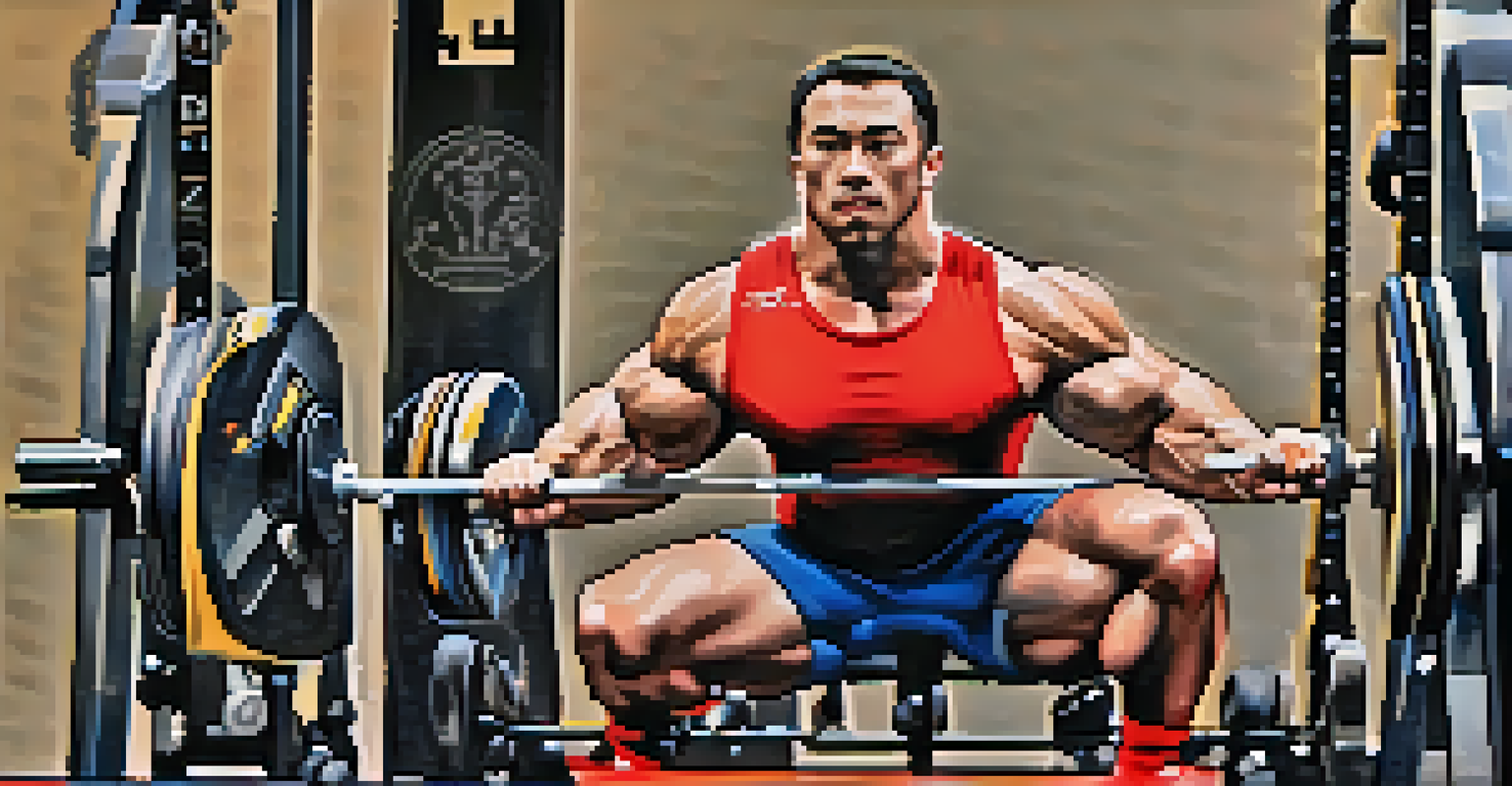Powerlifting: A Foundation for Enhanced Endurance Performance

Understanding Powerlifting and Its Core Principles
Powerlifting is a competitive strength sport focused on three main lifts: the squat, bench press, and deadlift. Each lift tests different muscle groups, promoting overall strength development. Unlike other forms of weight training, powerlifting is about maximizing strength in these specific movements, making it a unique approach to building muscle.
Strength does not come from physical capacity. It comes from an indomitable will.
At its core, powerlifting emphasizes technique, consistency, and progressive overload. This means that lifters gradually increase the weight they lift over time, pushing their limits while maintaining proper form. This structured training not only boosts muscle strength but also lays a solid foundation for various athletic endeavors.
Many athletes overlook the benefits of powerlifting, thinking it’s solely for those who want to compete. However, its principles can be applied to enhance performance in other sports, especially endurance activities. By building strength through powerlifting, athletes can experience significant improvements in overall performance.
The Connection Between Strength and Endurance
Strength and endurance might seem like two different worlds, but they actually complement each other in many ways. Endurance athletes often rely on muscle strength to maintain stamina over long periods. For instance, a stronger runner can push through fatigue more effectively, leading to improved race times.

When you think of endurance activities like running or cycling, it's easy to focus solely on cardiovascular training. However, incorporating strength training through powerlifting helps enhance muscle efficiency, allowing for better energy utilization. This means that your muscles can do more work with less energy, which is a game-changer in endurance sports.
Powerlifting Enhances Endurance
Incorporating powerlifting into endurance training builds strength and muscle efficiency, leading to improved athletic performance.
Moreover, strong muscles protect joints and reduce injury risk, which is crucial for endurance athletes who often face wear and tear. By building strength through powerlifting, athletes can improve their resilience during long training sessions and competitions, ensuring they stay in the game longer.
Enhanced Muscle Recruitment and Endurance
Powerlifting trains the body to recruit muscle fibers efficiently, which is essential for endurance performance. When you lift heavy weights, your body learns to engage multiple muscle groups simultaneously. This improved muscle recruitment can translate to better performance in endurance events, where every ounce of strength counts.
The difference between a successful person and others is not a lack of strength, not a lack of knowledge, but rather a lack in will.
For example, during a long-distance run, the ability to activate the leg muscles more effectively can delay the onset of fatigue. This means that a powerlifter's training could lead to longer, more efficient runs. Athletes who incorporate powerlifting into their regimen often notice they can maintain their pace for longer periods without feeling exhausted.
Additionally, the nervous system adapts to powerlifting training, enhancing coordination and overall movement efficiency. This means that endurance athletes can experience smoother transitions between movements, whether they’re running, cycling, or swimming. Ultimately, improved muscle recruitment fosters greater endurance performance.
Improved Posture and Stability for Endurance Athletes
Good posture is a vital aspect of any athletic performance, especially for endurance athletes. Powerlifting promotes strong core and back muscles, which are crucial for maintaining proper alignment during prolonged activities. When your body is stable and aligned, it reduces the risk of injury and allows for more efficient movement.
Consider a cyclist who has a strong core; they can maintain their position on the bike for longer periods, leading to better performance. Powerlifting enhances these stabilizing muscles, helping athletes hold their form longer while reducing fatigue. This stability translates into better power transfer, whether you're running or cycling.
Boosting Mental Toughness
The mental discipline gained from powerlifting helps endurance athletes overcome challenges and stay motivated during long events.
Furthermore, a strong, stable body can better handle the physical demands of endurance training. With a solid foundation from powerlifting, athletes can push their limits while minimizing the risk of injuries caused by poor posture or instability. This means that powerlifting not only improves strength but also ensures longevity in sports.
Boosting Mental Toughness Through Powerlifting
Powerlifting is as much a mental challenge as it is a physical one. Lifters often push through heavy weights, learning to overcome mental barriers and develop resilience. This mental toughness is incredibly valuable for endurance athletes, who need to stay focused and motivated during long events.
For instance, when facing fatigue during a marathon, an athlete's ability to push through discomfort often determines their success. The mental fortitude gained from powerlifting helps athletes confront and conquer these challenges. By regularly facing and overcoming obstacles in the gym, athletes can build confidence that translates to race day.
Moreover, the discipline required in powerlifting—following a structured training regimen, tracking progress, and setting goals—instills a strong work ethic. Endurance athletes who adopt this mindset can improve their training consistency and commitment, which are critical factors for achieving long-term success.
Integrating Powerlifting into Your Endurance Training
If you’re an endurance athlete looking to incorporate powerlifting into your training, start with a balanced approach. Begin by dedicating one or two days a week to focused strength training, emphasizing the three main lifts. This doesn’t mean abandoning your endurance training; rather, it complements it.
A well-structured program should include both powerlifting sessions and your usual endurance workouts. For example, you might lift weights on Mondays and Thursdays while running or cycling on other days. This allows your body to adapt to both strength and endurance training without overloading yourself.
Improved Posture and Stability
Powerlifting promotes strong core and back muscles, essential for maintaining good posture and reducing injury risk in endurance activities.
Always prioritize proper technique over lifting heavy weights. If you're new to powerlifting, consider working with a coach or experienced lifter to ensure you’re using the right form. This will not only maximize your strength gains but also minimize the risk of injury as you integrate powerlifting into your routine.
Conclusion: Powerlifting as a Pathway to Endurance Success
Incorporating powerlifting into your training can be a game-changer for endurance athletes. By building strength, enhancing muscle recruitment, and improving posture, powerlifting offers numerous benefits that directly translate to better performance in endurance sports. It’s about creating a well-rounded athlete who can tackle any challenge.
As you embark on this journey, remember that the key is consistency and patience. Just like endurance training, powerlifting requires time to see results. Embrace the process, enjoy the journey, and watch as your endurance performance flourishes.

Ultimately, powerlifting is more than just lifting weights; it’s about building a strong foundation for whatever athletic endeavors lie ahead. Whether you're running a marathon or cycling a century ride, the strength gained from powerlifting can propel you to new heights.